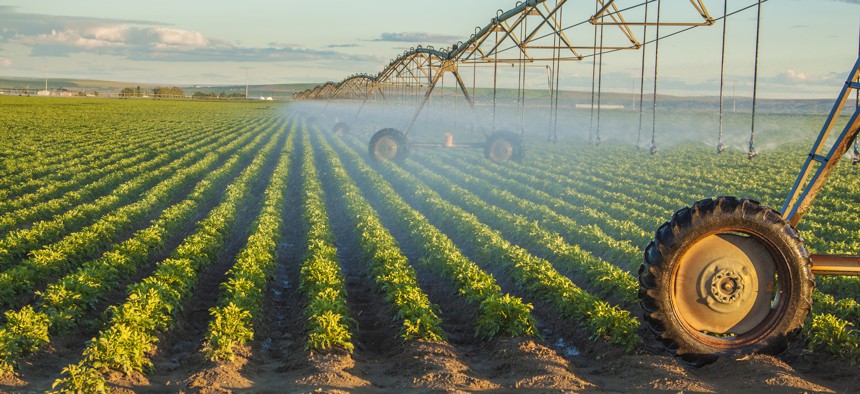How Can Local Governments Help California’s Farmers Save Water?

A pivot sprinkler system irrigates a farm. Alex Misu / Shutterstock.com

Connecting state and local government leaders
Agricultural interests insist they’re doing their part but most growers don’t use efficient drip agriculture and several counties have banned drought-tolerant crops.
When it comes to California’s four-year drought, farmers want residents to know they’re reducing water use, too.
Farming accounts for 40.9 percent of state water use, according to the Agricultural Council of California, but in 2014, 41.6 percent of irrigated farmland had its water supply cut 80 percent or more.
The 15,000-plus farmer advocacy group expects about 800,000 acres of farmland to go uncultivated in 2015—costing 23,000 jobs and $5.7 billion.
“It shouldn’t be green lawns versus green vegetables,” Ag Council President Emily Rooney said in a statement. “We are all in this together, and we want Californians to understand how the drought is affecting small family farms and the food supply by providing reliable, consistent information.”

In 2014, around 438,000 acres of fallow land resulted in the loss of 17,000 farm-related jobs and $2.2 billion to California’s economy.
No strangers to water conservation, many farmers employ drip irrigation and plant genetically-modified crops that require less water, according to the Ag Council. Almond growers improved water efficiency 33 percent in the last 30 years, and a 65 percent less water goes into producing a glass of milk than in 1944.
Still, some have criticized Gov. Jerry Brown from exempting agriculture from his statewide 25 percent mandatory reduction in water use.
Local government isn’t doing enough to encourage farmers to plant drought-tolerant crops, Stanford University molecular biologist Henry I. Miller wrote this month in Forbes:
Using about 80% of California’s water, the state’s farmers grow the majority of the nation’s fruits, nuts and vegetables, but as yet there have been few commercialized genetically engineered varieties of these “specialty crops.”
Astonishingly, in spite of the intensive, safe and commercially successful cultivation of genetically engineered plants for two decades, four California counties have banned their cultivation, via either ordinances or referendums. These actions in Trinity, Mendocino, Marin and Santa Cruz counties represent political leadership and voter ignorance at their absolute worst, obstructing a route to greater prosperity for farmers, greater food security for the nation—and water conservation.
The Ag Council disputes Miller’s 80 percent figure, arguing it includes 50.2 percent of water actually preserved for environmental purposes, but most California farmers might not be as water efficient as the Council lets on, environmental consultant Ellen Moyer wrote in earlier this month in The Huffington Post:
In their defense, California farmers have improved irrigation efficiency in the past several decades, spending billions on improvements and increasing crop production per unit of water by 43 percent over the last 40 years. As of 2010, low-volume methods such as drip irrigation were used on 38 percent of California farmland, and California leads the U.S. in the use of low-volume methods. Drip irrigation delivers water directly to the roots of the plants, with almost no evaporation or surface runoff. However, gravity irrigation was still used on 43 percent of farmland. Gravity irrigation involves moving water across farm fields, either in broad sheets or via a grid of ditches. As much as half of gravity irrigation water does not reach the crops. Sprinklers, which lose water to evaporation, were used to irrigate 15 percent of farmland.
The Ag Council projects almost 30 percent of irrigated farmland will see no surface water in 2015, increasing the number of farmers investing in water-saving technologies.
Among those innovations: A nontoxic gel from Moasis Inc. stores and slowly releases water near crop roots when mixed with soil; satellite or aerial images helping farmers plan irrigation based on how crops look; and PowWow Energy Inc.’s water pump monitor that can detect leaks in irrigation equipment, The Wall Street Journal recently reported.
“If we can grow more food with our water, that’s presumably what we would like to do,” UC Davis agricultural economist Daniel Sumner told The Journal.
Dave Nyczepir is News Editor for Government Executive’s Route Fifty.

NEXT STORY: Portland, Oregon’s First Responders Will Be Marooned by Mega Quake; Watch Out for ‘Wayward Cherries’





